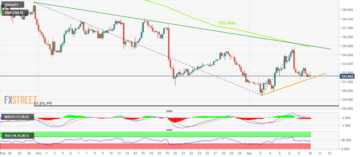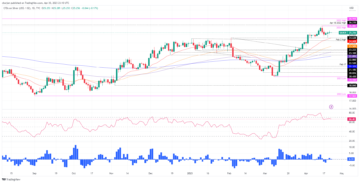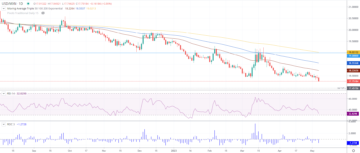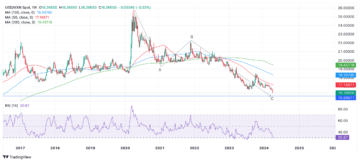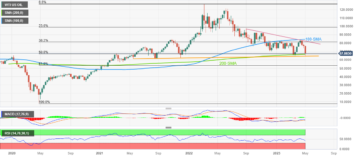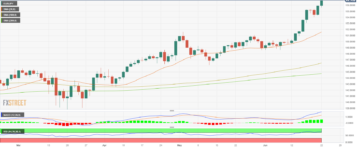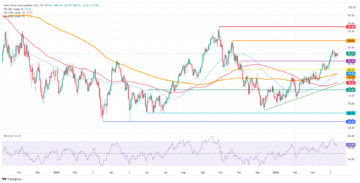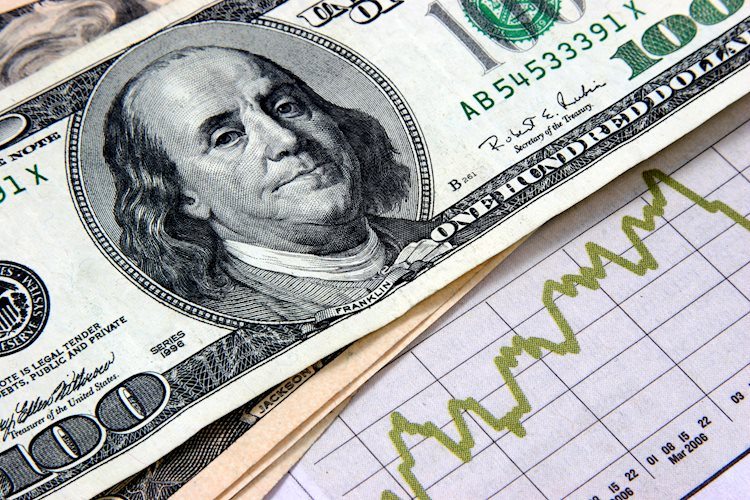
Markets are on pause, awaiting catalysts. It will be the week before the central bank’s weeks. Major currency pairs are moving sideways, with a mixed US Dollar, holding on to recent losses versus EUR and GBP. The pattern could continue next week, considering that the first week of May is crucial with monetary policy decisions in Australia, the US and the Euro Zone and the US official employment report. The economic calendar is light next week, being the most relevant reports Australian and German inflation, US GDP and the monetary policy meeting in Japan. End-of-month flows could add to volatility.
Here is what you need to know for next week:
On Saturday, the Federal Reserve (Fed) blackout period begins, ahead of the May 2-3 meeting. The lack of comments from Fed officials could lead to quieter markets next week; however, there will be important economic reports. According to the CME FedWatch Tool, the odds of a 25 basis points rate hike were 88% after the US preliminary April PMI, up from 77% a week ago. It is seen as the last rate hike of the current tightening cycle.
The critical report in the US will be first-quarter GDP growth (advance estimate), with market consensus pointing to an expansion at a 3.9% annualized rate. Also important will be the Core Personal Consumption Expenditure included in the GDP report and on Friday in the Personal Income and Spending report. It is the Fed’s preferred inflation gauge.
Wall Street finished the week with modest losses, moving without a clear direction. Main indexes pulled back from monthly highs. The rally that started mid-May has run into resistance.
The US Dollar Index (DXY) rose for the first time in six weeks, but the trend is down. The DXY remains above the key 101.50 support. Since Tuesday, it has been moving sideways, as markets await the next catalysts. The Dollar benefited as market participants pared Fed rate cut bets for the third and fourth quarters.
The Japanese Yen was among the worst performers affected by higher government bond yields across the globe. The US 10-year yield settled at 3.55%, the highest weekly close since early March, but far from highs. Next week, the Bank of Japan will have its first monetary policy meeting under Kazue Ueda. No change is expected in the policy stance. Current forecasts see an adjustment to the Yield Curve Control, as early as June.
USD/JPY posted a modest weekly gain, after being rejected from above 135.00. EUR/JPY and GBP/JPY also ended with small appreciations, showing some signs of a potential reversal.
EUR/USD traded all week under 1.1000 and above 1.0900, in a modest range, ending a seven-week positive streak. The bias continues to the upside, supported by expectations of more rate hikes from the European Central Bank (ECB) and a weaker US Dollar.
Despite upbeat UK economic data (except Retail Sales) and higher-than-expected inflation numbers that boosted expectations of more tightening from the Bank of England, the Pound posted minor gains versus the Dollar. GBP/USD moved all week near 1.2400. The pair continues to move sideways. EUR/GBP pulled back a bit after surging in the previous week.
AUD/USD remains capped by the 20-week Simple Moving Average (SMA) and is unable to move away from the 0.6700 area. The relatively hawkish Reserve Bank of Australia (RBA) minutes and positive employment data from Australia failed to lift the Aussie. AUD/NZD soared for the second week in a row but was boosted by a decline in the New Zealand Dollar.
The Kiwi remained weak, affected by New Zealand Q1 inflation figures. NZD/USD posted the third weekly loss in a row, around 0.6140. The bias is to the downside, with the price looking at the 0.6100 support area. Next week, Reserve Bank of New Zealand’s chief economist Paul Conway will speak about monetary policy.
USD/CAD rose more than 1% during the week climbing above 1.3500, to the 20-week SMA. The Loonie was the worst among majors, suffering from the decline in crude oil prices and the divergence between a Bank of Canada (BoC) on hold, and the rest of the central banks still raising rates.
During the week, the Brazilian Real fell the most (USD/BRL rose from 4.90 to 5.05), followed by the Colombian Peso, with USD/COP increasing 2.48%, trimming some of its recent losses.
It was a terrible week for cryptocurrencies. Bitcoin had the worst week since November; BTC/USD fell from $30,300 to $27,850. Ethereum retreated from above $2,100 to $1,880.
Gold pulled back, having the most significant weekly loss in two months, closing below $2,000. Silver also retreated and stabilized around $25.00 on Friday. Crude oil prices dropped more than 5% despite robust economic data. Uncertainty around global economic activity and interest rates weighed on the outlook for crude oil.
Like this article? Help us with some feedback by answering this survey:
- SEO Powered Content & PR Distribution. Get Amplified Today.
- Platoblockchain. Web3 Metaverse Intelligence. Knowledge Amplified. Access Here.
- Source: https://www.fxstreet.com/news/forex-today-dollar-rises-timidly-on-cautious-markets-202304211849
- :has
- :is
- $UP
- 000
- 1
- 100
- 50
- 7
- a
- About
- above
- According
- across
- activity
- Adjustment
- advance
- After
- after surging
- ahead
- All
- also
- among
- an
- and
- annualized
- April
- ARE
- AREA
- around
- article
- AS
- At
- Australia
- Australian
- average
- await
- awaiting
- back
- Bank
- bank of canada
- bank of japan
- Banks
- basis
- BE
- been
- before
- being
- below
- Bets
- between
- bias
- Bit
- Bitcoin
- BoC
- bond
- Bond yields
- Boosted
- BTC/USD
- but
- by
- Calendar
- Canada
- catalysts
- cautious
- central
- Central Bank
- Central Banks
- change
- chief
- clear
- Climbing
- Close
- closing
- CME
- comments
- Consensus
- considering
- continue
- continues
- control
- Core
- could
- critical
- crucial
- crude
- Crude oil
- Currency
- currency pairs
- Current
- curve
- Cut
- cycle
- data
- decisions
- Decline
- Despite
- direction
- Divergence
- Dollar
- dollar index
- down
- downside
- dropped
- during
- Dxy
- Early
- ECB
- Economic
- Economist
- employment
- estimate
- ethereum
- EUR
- Euro
- Euro Zone
- European
- European Central Bank
- expansion
- expectations
- expected
- Failed
- far
- Fed
- feedback
- Figures
- First
- first time
- Flows
- followed
- For
- forex
- Fourth
- Friday
- from
- Gain
- Gains
- GBP
- GDP
- German
- German inflation
- Global
- Global Economic
- globe
- Government
- Have
- having
- Hawkish
- help
- higher
- highest
- Highs
- Hike
- Hikes
- hold
- holding
- However
- HTTPS
- important
- in
- included
- Income
- increasing
- index
- indexes
- inflation
- inflation figures
- interest
- Interest Rates
- into
- IT
- ITS
- Japan
- jpg
- Key
- Know
- Lack
- Last
- lead
- light
- looking
- loss
- losses
- Main
- major
- major currency
- Majors
- March
- Market
- Markets
- May..
- meeting
- minor
- minutes
- mixed
- Monetary
- Monetary Policy
- monthly
- months
- more
- most
- move
- moving
- moving average
- Near
- Need
- New
- New Zealand
- next
- next week
- November
- numbers
- NZD/USD
- Odds
- of
- official
- officials
- Oil
- on
- Outlook
- pairs
- participants
- Pattern
- Paul
- performers
- period
- personal
- Peso
- plato
- Plato Data Intelligence
- PlatoData
- points
- policy
- positive
- posted
- potential
- preferred
- previous
- price
- Q1
- raising
- rally
- range
- Rate
- Rate Hike
- rate hikes
- Rates
- RBA
- real
- recent
- relatively
- relevant
- remains
- report
- Reports
- Reserve
- reserve bank
- reserve bank of australia
- Reserve Bank of Australia (RBA)
- Reserve Bank of New Zealand
- Resistance
- REST
- retail
- Reversal
- Rises
- robust
- ROSE
- ROW
- Run
- s
- Second
- Settled
- sideways
- significant
- Signs
- Simple
- since
- SIX
- SMA
- small
- soared
- some
- speak
- Spending
- started
- Still
- street
- suffering
- support
- Supported
- Survey
- than
- that
- The
- There.
- Third
- this
- tightening
- time
- to
- today
- tool
- traded
- Trend
- Tuesday
- Uk
- Uncertainty
- under
- Upside
- us
- US 10-year yield
- US Dollar
- US GDP
- Versus
- Volatility
- was
- week
- weekly
- Weeks
- were
- What
- will
- with
- without
- Worst
- Yield
- yield curve
- yield curve control
- yields
- you
- Zealand
- zephyrnet


